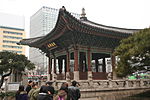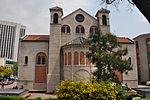Climate of Seoul
The climate of Seoul features a humid continental climate with dry winter, called "Dwa" in the Köppen climate classification. Seoul is classed as having a temperate climate with four distinct seasons, but temperature differences between the hottest part of summer and the depths of winter are extreme. In summer the influence of the North Pacific high-pressure system brings hot, humid weather with temperatures soaring as high as 35 °C (95 °F) on occasion. In winter the city is topographically influenced by expanding Siberian High-pressure zones and prevailing west winds, temperatures dropping almost as low as -20 °C (-4 °F) in severe cold waves. The bitterly cold days tend to come in three-day cycles regulated by rising and falling pressure systems. The most pleasant seasons for most people in the city are spring and autumn, when azure skies and comfortable temperatures are typical. Most of Seoul's precipitation falls in the summer monsoon period between June and September, as a part of East Asian monsoon season.
Excerpt from the Wikipedia article Climate of Seoul (License: CC BY-SA 3.0, Authors).Climate of Seoul
Sejong-daero, Seoul Myeong-dong
Geographical coordinates (GPS) Address Nearby Places Show on map
Geographical coordinates (GPS)
| Latitude | Longitude |
|---|---|
| N 37.568888888889 ° | E 126.97666666667 ° |
Address
광화문
Sejong-daero
03186 Seoul, Myeong-dong
South Korea
Open on Google Maps








